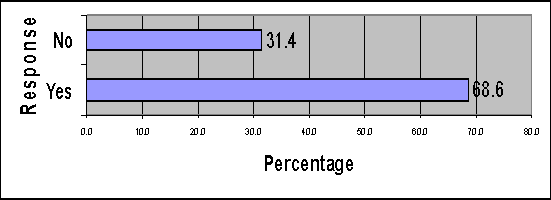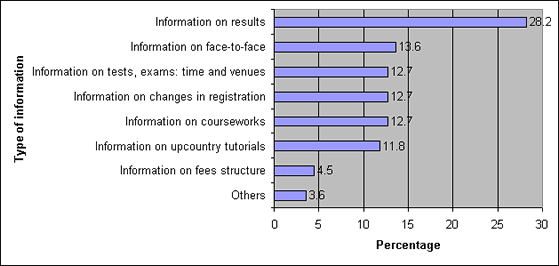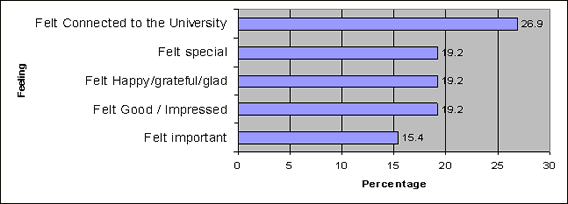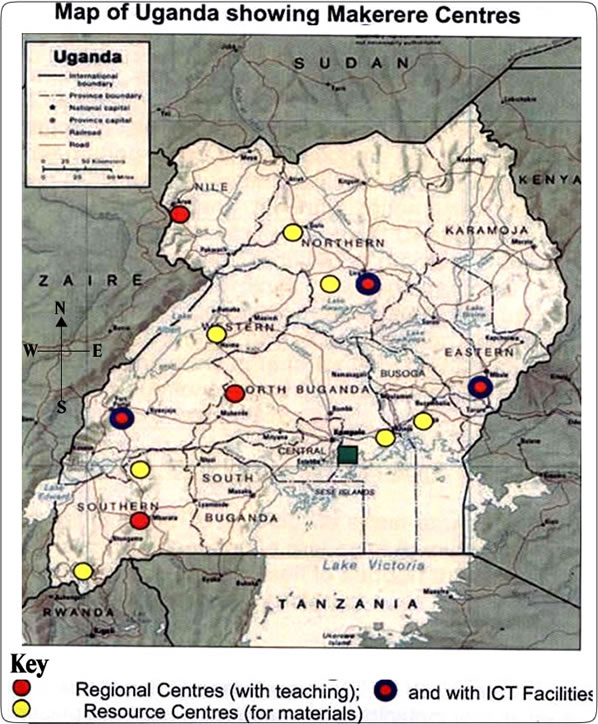|
The effectiveness of mobile short messaging service (SMS) technologies in the support of selected distance education students of Makerere University, Uganda Richard Kajumbula, Makerere University Abstract
1.0 INTRODUCTION Distance education (DE) providers face the challenge of improving student support services so as to enhance the performance of students who are in most cases dispersed. Learner support is a system designed to assist the learner to use the study materials offered to him/her for study effectively and efficiently and be in position to adjust his/her lifestyles and study steadily so that he/she can complete the course embarked on. It aims at reducing the isolation of a distance learner, increasing peer and instructor's interaction, inculcating self-discipline among the students and avoiding loss of interest. Support includes, among others, peer support sessions (study groups), tutorials, teaching in assignments, and Internet communication (including Short Messaging System (SMS)) all attempting to close the gap between the learner and the tutor who are separated in space and time for more than the usual time (Bbuye, 2005).
Makerere University (MAK), a dual mode institution, has been running DE degree programs since 1991 (Aguti, 2000:p.256). The programs are managed by the Department of Distance Education (DDE) in the Institute of Adult and continuing Education (IACE) in collaboration with academic faculties. DDE carries out student support activities to students scattered in many parts of Uganda and the commonest medium of communication to students is radio. However, this medium has no room for the recipient to store the message for future reference and there is uncertainty as to whether, at the time the announcement passes, the target audience is listening in.
To enhance communication between students and staff and ensuring that students do not miss out on important activities or even feel isolated which may cause them to drop out, DDE acquired a software program known as DDE BROADCAST SYSTEM from SOCNET Solutions Limited, a software development company in Uganda. This program has capacity to send instant messages to the mobile phone of a student and to the email address provided by the student. The tool communicates to two out of the three mobile service providers in the country. It can be compared to the Chikka Network in the Philipines (Mariano & De La Rosa, 2004).
The role of SMS communication in universities is not new in the developing world. In The Philippines, which is known as `the texting capital of the world', SMS is one of the students' favourite means of communication with faculty and other students (Pabico, 2003; Mariano & De La Rosa, 2004). This was the same finding by Nonyongo, Mabusela and Monene (2005) about UNISA students. Since on average, mobile phones have a capacity of 160 letters per message, abbreviated spelling has evolved to extend messages and at the same time get the messages clearly to the other person making communication to students easier (Mariano & De La Rosa, 2004).
However, there is always a fear in introducing new technology. Even if it has worked elsewhere, to MAK it is like “Leaping into the dark”. Steven Gilbert, President of the Teaching, Learning, and Technology (TLT) wrote an article called “Why Bother”. He asked, "Why bother making great investments of money, time, and effort to increase educational uses of information technology in colleges and universities? “Why should an academic leader risk making a technology investment decision that may make him/her look wasteful or foolish in 12 to 24 months? Or sooner!” His short answer was: “Because more people will be able to learn and teach better.”
Given that question, the introduction of technology has benefits, if applied properly. A huge sum of money has been invested in purchasing the software and if not applied well, this money may end up among the department's sunk costs. The use of the cellular phone as well as the popularity of SMS is increasing in Uganda and in other countries and MAK has to find the most appropriate way of applying the technology. This being the first time such an application of technology is happening in MAK, many sceptics still arise as to whether this will be successful in enhancing management of the distance education program especially the student support component. This study, therefore, sought to establish the effectiveness of SMS communication among selected DE students and to recommend a method of applying this technology at the maximum benefit to the student and minimum cost to DDE.
2.0 METHODOLOGY The research design was exploratory since effectiveness of a new technology is being tested. The survey population included distance education students. Using cluster sampling, 58 out of 78 (74.4%) upcountry students were selected. The cluster involved first year Bachelor of Commerce External upcountry Distance Education students of Makerere University, Uganda since the technology has been introduced with their entry. The students were invited during a face to face session and interviewed. Upcountry centers include Jinja, Mbale, Lira, Arua, Fort Portal, Hoima and Mbarara. The source of data was Primary. Interviews were also carried out with tutors and administrators using an interview guide and students were surveyed using the questionnaire method. This study borrows some methods as applied by Nonyongo, Mabusela and Monene (2005) who carried out a study on student SMS usage in UNISA.
3.0 FINDINGS 3.1 Characteristics of Respondents The students selected were of varying age and gender as shown in the table below;
Table 1: Age and gender of respondents
Source: Primary data
Most of the respondents fell in the age range of 20 - 29 years followed by 30 - 39 years implying that students are of varying age. Most of these students are male. There is however a deliberate effort to try and increase the university entry of women with the coming up of the affirmative action scheme.
3.2 Students' Nearest MAK Regional Center Students enrolled on the MAK External Degree programme are scattered across the countryside and the results of this study reflected this. They were from seven upcountry centres as shown in Table 2. Because of this, reaching them physically is difficult hence a need for a good communication system to help them save costs of travel to main campus for information. See also appendix I which gives the location of these centres in the country.
Table 2: Nearest MAK Regional Center
Source: Primary Data
3.3 Students' Access to Mobile Phones Access to mobile phones among the students is increasing. Out of the 58 students reached, 56 (96.6%) have mobile phones with only 2 (3.4%) without mobile phones. This level of access to mobile phones compares quite well with Mbarika and Mbarika (2006) findings that in Uganda more than 50% of the population has mobile cellular coverage. This level of access implies the mobile phone has huge potential to improve communication between MAK and its students and therefore the need for the DDE to deliberately seek to exploit the availability of this technology in its support services.
The use of SMS communication in education and student support is common in developing countries like The Philipines and Mongolia. The Philippines has been named the world's texting /SMS capital, with more than 2 million SMS sent each day from over 13 million cellular phone subscribers (Pabico, 2003). Cellular phones and SMS have become an important aspect of Filipino life and usage of this communication system is wide -ranging from the more personal use to business and education (Coronel-Ferrer, 2002). Mongolia and Philipines are some of the countries where technology has been noted to have the most promise in terms of using texting as a possible tool in providing education (Ramos, 2006).
3.4 Findings on SMS Communication and its Effectiveness SMS communication is applicable where students' mobile telephone numbers are available. In MAK, the students are asked to submit their numbers so that communication to them is possible and as already said, 96.6% of those interviewed have mobile phone numbers and submitted these numbers to the Department. Having phone numbers of the students is vital because the department can communicate to them and provide feedback on whatever they need to know.
3.4.1 Students' Receipt of SMS From the Department Before Installing the Program. Before the software was installed, students were asked as to whether they had ever received any SMS communication from the DDE. Only 10 (17.2%) had ever received an SMS while the majority, 47 (81%), had never received any. One student did not respond to this question. The few that had received it had only got messages from individual program coordinators.
When students were asked as to whether they wished to receive SMS messages from the DDE, 57 (98.3%) wished to receive such communication except one who said that he uses his uncle's mobile phone to communicate and worse still, in their region, network is on and off. This implies that if the Department is to fully employ SMS for student support, it should remember that not all students will have access to the mobile phone network. Such students would need to be traced and given alternative support.
These findings emphasize that SMS is one of the students' favourite means of communication with DDE and other students. Moreover, PC-to-mobile phone messaging system costs the user nothing when connected to the Internet (Mariano & De La Rosa, 2004).
3.4.2 Students' Receipt of SMS From the Department After Installing the Program. After installation of the SMS software, students were sent messages and on the follow up study, they were asked as to whether they had received the messages and figure 1 shows the responses where 68.6% of the students received the communication while 31.4% did not. On further inquiry from the systems administrator as to why some students did not receive, it was established that the program takes time to deliver the messages and at times if the person is in a place with poor network, the message may not be delivered at all. However, this is to be rectified since the program is still in the testing phase.
3.4.3 The Type of Information Students Wished to Receive Through SMS Later when asked the type of information they wished to be communicated to, they presented the following: The reasons classified under `Others' included course units to be covered, timetables, fees updates and new stock of textbooks. From these responses, the kind of information students want to be given using SMS covers critical areas in the life of a distance education student. This implies that SMS communication is necessary and should be well integrated in the Department's communication strategy. This is in line with the findings in the Philippines. It is interesting to note that Filipino students, especially in modes of education like open learning and distance education systems that have less face-to-face and classroom interaction, often use SMS and email messaging systems to foster interaction and learning. The use of these messaging systems in education has become an indispensable communication system and an important aspect of teaching and learning (Pabico, 2003). Its implications for distance education policy-making, administration, curriculum development and instruction are, therefore, worth examining.
3.4.4 Effectiveness of SMS Communication The students were asked whether communication between them and the department was effective, that is, if they received information on upcoming events in time, got feedback on queries and other relevant communication from the university. 26 (44.8%) said communication was effective while 27 (46.6%) said it was not yet effective. The introduction of the software will enhance such. They suggested that radio communication and actual telephone calls should continue to supplement the SMS communication. After installing the program, SMS messages were sent during the semester. Students were again invited to comment on whether communication between them and the department had improved. From this follow up survey, in which 52 students participated, 42 (80.7%) agreed that they had received relevant and timely information from the department about important events at the main campus and at centers while 10 (19.3%) said that more should be done to reach them because information reached late to some and others did not receive any messages.
3.4.5 How Students Felt When They Received SMS from the Department This question was necessary because, since most of the distance learners are isolated for most of the time, frustration is a common problem. Establishing the feelings SMS elicits from students would be an indicator of how SMS deals with frustrations associated with isolation. The responses received showed that students have positive feelings when they receive the messages from the department. Their feelings have been categorized and the figure below shows the findings; Majority of them (26.9%) felt connected to the university. This satisfies one of the objectives of student support which is to reduce the isolation the students felt and to reduce the `distance' they felt as a result of being far from the main campus. Being `connected' to the university also implies having a sense of belonging which is vital for the students' morale and esteem.
3.4.6 Comments by Tutors and Administrators about SMS Communication with Students Tutors and administrators commented that SMS communication can enhance both academic and administrative support to students. Students can know whether their marks are missing, dates for tutorials, face-to-face sessions and examinations, venues and meeting times with research supervisors. This enhances effectiveness of communication between students and staff as Briggs and Smith (2001) also emphasised.
4.0 CONCLUSIONS AND RECOMMENDATIONS This study has revealed that students' access to mobile phone technology is very high and therefore the mobile phone presents a very attractive option to easing communication between the students and the Department. The study also shows that there are a number of advantages that accrue from the use of SMS for communication. Students prefer SMS because it keeps them informed of what is happening at the University. Most students felt happy and connected to the university. This satisfies one of the objectives of student support; reducing the isolation students feel and reducing the `distance' they feel as a result of being far from the main campus.
Use of SMS can also save the department a lot of money spent on announcements over radios and news papers. Tutors and staff too can provide both academic and administrative counselling to students and give feedback to students' queries at no cost. This shows that SMS communication is an effective way of supporting distance education learners.
To move this initial study forward, it is recommended that:
REFERENCES Aguti, J.N. (2000). Makerere University (Dual Mode University) Uganda. In V.V. Reddy & S. Manjulika, (Eds). The World of Open and Distance Learning, (pp. 255 - 280). , New Delh0i: Viva Books Private Limited. Bbuye, J. (2005) Distance Education In Uganda. Paper presented at the Seminar on Modern Distance Education 9th - 28th September 2005. Jilin University, Peoples Republic of China
Coronel-Ferrer, M. (2002) “Politics of mobile phones”. A Philippine Journal of Third World Studies, Vol. 17, no. 2, pp. 3-6. Kelsey, K. D.and, D'souza, A (2004); Student Motivation for Learning at a Distance: Does Interaction Matter? Online Journal of Distance Learning Administration, Volume VII, Number II, Summer 2004 State University of West Georgia, Distance Education Center Available at http://www.westga.edu/~distance/ojdla/summer72/kelsey72.html Mariano, M. L. D and De La Rosa, N. P. C., (2004) Beyond an Institutionalized Learning Environment:Fostering Interactions and Learning Using Synchronous and Asynchronous Messaging Systems. Turkish Online Journal of Distance Education-TOJDE July l ISSN 1302-6488 Vol. 5 no: 3 Available at http://tojde.anadolu.edu.tr/tojde15/pdf/mariano.pdf. Mbarika, V and Mbarika, I (2006).; Burgeoning wireless networks connect Africans to the world and each other A publication in Spectrum Online (IEEE), Africa Calling. Available at http://www.spectrum.ieee.org/may06/3426 Nonyongo, E; Mabusela, K; Monene, V. (2005) Effectiveness of SMS Communication between university and students (Institute for Continuing Education, UNISA). Available at www.mlearn.org.za/CD/papers/Nonyongo&%20Mabusela.pdf Pabico, A. (2003). Teaching through mobile technology debuts in schools. Retrieved from http://ipsnews.net/interna.asp?idnews=18701
Ramos, A. J. O; The viability of mobile SMS technology for Non-formal Diastance Learning in Asia. A Publication for Melve Development Foundation Inc. Available at www.pandora-asia.org/downloads/05-AAOU_Ramos.pdf
1
Figures | |||||||||||||||||||||||||||||||||||||||||||||||||||||||||||||||||||



